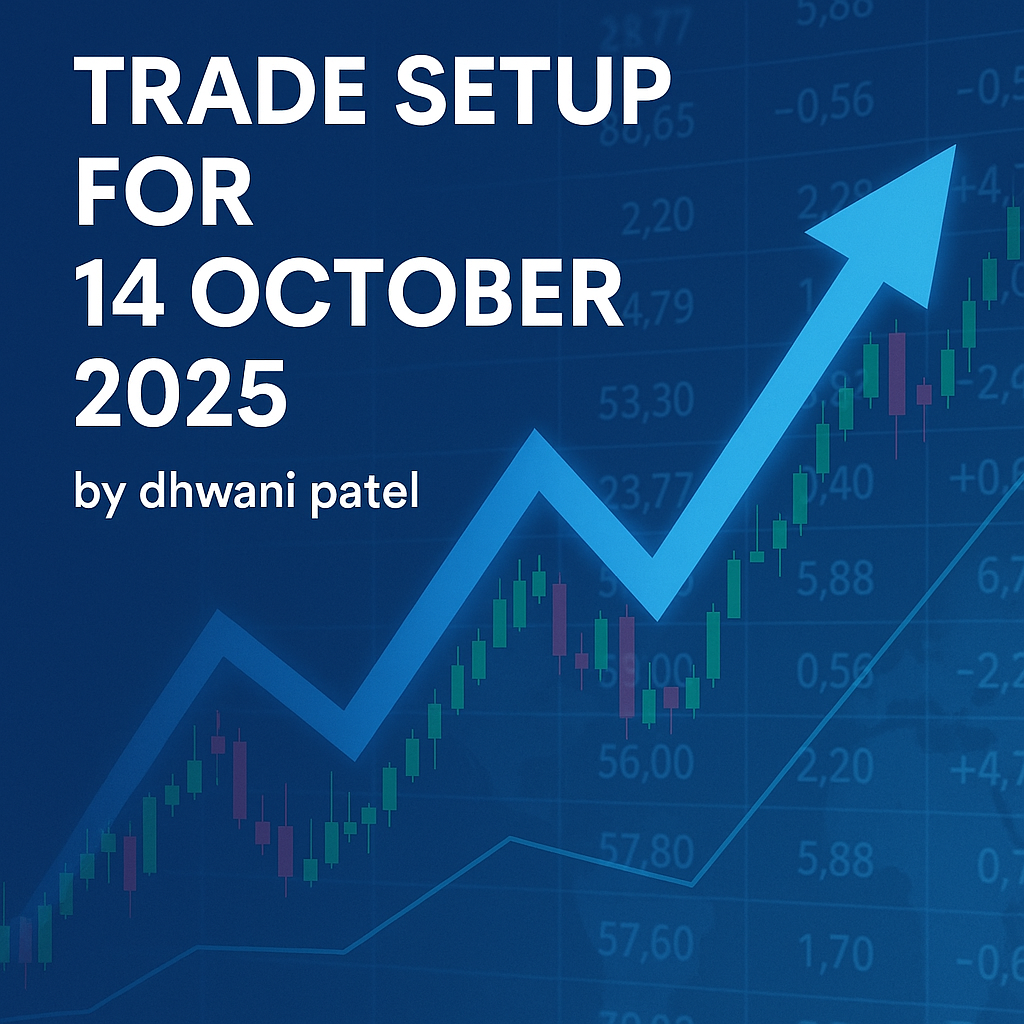
Introduction
Markets thrive or wobble based on how participants interpret key zones, flows, and direction cues. For October 14, 2025, the trade setup is shaped by resistance and support levels published in the recent market brief, alongside derivative and volatility data. In this article, dhwani patel breaks down 10 trade-relevant setups using those levels plus original insight — designed for both intraday and short swing traders.
Let’s get into it.
Setup 1 — Nifty 50: Resistance & Support Zones
According to the updated market summary, resistance for the Nifty lies close to 25,650–25,700, while support zones are in the 25,300–25,250 region.
This band will act as the primary battlefield. If Nifty pushes above 25,650 with conviction, further upside may unfold. On the flip side, a drop below 25,300 can invite broader weakness.
Traders using a Nifty futures trading guide can reference this zone to shape directional bias: stay alert for clean breaks or retests.
Setup 2 — Bank Nifty: Financial Index Barometer
In the same report, Bank Nifty’s resistance is placed near 57,600–57,800, with support zones around 56,800–56,500.
Since banks carry disproportionate weight and sentiment influence, this index often leads or confirms the broader market’s direction. If Bank Nifty breaks above 57,800 convincingly, expect more participation in financial counters; if it falters below 56,800, it may drag broader indices.
For those employing index futures trading strategies India, watching Bank Nifty’s reaction within these levels can give early clues on strength or weakness.
Setup 3 — Call OI Concentration: Resistance Clues
Call open interest is concentrated at strikes like 26,000, 25,800, 25,700 (as per the report). These levels may act as supply zones where participants expect price struggles.
When price approaches these strikes:
- If it punches through with volume and additional call OI, that’s bullish validation.
- If it stalls or reverses, these strikes become resistance traps.
Options traders and futures traders alike should watch such zones when planning entries or stops.
Setup 4 — Put OI Pivots: Support Anchors
Heavy put interest resides at strikes such as 25,300, 25,200, and 25,000 (as mentioned). These create implied support zones.
If Nifty drifts toward these zones and holds, buyers may step in. But a decisive breach, especially with increase in put OI, could signal a shift to downside momentum.
Traders can treat these as reference support bands for bias shifts or defensive posture.
Setup 5 — Bank Nifty Option Structure
Bank Nifty’s call OI shows heavy clustering around 58,000 and 57,500, while on the put side, strikes like 56,000 draw significant interest.
This suggests resistance near 58,000 and support near 56,000. If Bank Nifty breaks past 58,000, it may carry momentum into broader indices; but if it retreats, those put zones may buffer downside.
Using these with futures strategies helps align entries with where major participants have positioned.
Setup 6 — Put-Call Ratio (PCR) & Market Mood
Rising PCR indicates more participants hedging or expecting downside, while a declining PCR suggests risk appetite.
Use PCR shifts as a confirmatory filter — when price nears key levels and PCR moves in tandem, it strengthens conviction. But don’t treat PCR alone as a trade trigger.
Setup 7 — Volatility & India VIX
The market commentary suggests volatility may remain stable but susceptible to spikes. If India VIX jumps during the session, the range may expand and directional edges may get more pronounced.
Traders should be ready for both scenarios: extended runs or sharper reversals.
Setup 8 — Flow & OI Dynamics
The report highlights long build-ups, short covering, and OI shifts across stocks. Recognizing which counters are seeing aggressive positioning gives hints about where institutional money is flowing.
Combine that with relative strength and technical structure to filter better names for swing or intraday action.
Setup 9 — Delivery Data & F&O bans
Stocks showing high delivery percentages reflect true accumulation beyond speculative interest. At the same time, stocks under F&O ban tend to behave erratically since new positions can’t be added freely.
Knowing which names fall in these categories helps you avoid traps and capture higher-quality setups.
Setup 10 — Macro & Global Backdrop
Global cues — crude, U.S. futures, bond yields, policy news — act as accelerators or spoilers. Even if domestic levels hold, external shocks can override direction quickly.
Traders should monitor global indices and commodity price moves throughout the session as overlay context.
Integration into a Trading Framework
Here’s a suggested workflow (educational, not trade recommendations):
- Pre-Session Scan (before market opens):
- Check where Nifty opens relative to 25,650 / 25,300 zones
- See Bank Nifty’s position relative to 57,800 / 56,800
- Map call/put OI clusters
- Note PCR, VIX trends
- Bias Definition:
- Above resistance = bullish bias; below support = cautious
- Mixed zone = neutral/range mode
- Entry Logic:
- Look for confirmed break + volume + OI shift for trend plays
- Or retests of zones after breakout for safer entries
- In options, prefer defined-risk structures near leverage zones
- Risk & Sizing:
- Use smaller size near heavy OI zones or high VIX
- Always place stop-losses just beyond key levels
- Mid-Session Adjustments:
- Reassess flows & OI changes
- Watch for sector rotation
- If global cues turn volatile, consider partial exits or hedges
This aligns well with principles behind index futures trading strategies India and fits naturally with swing trading strategies India thinking.
Final Thoughts & Reminder
This Trade Setup for 14 October 2025 uses the resistance and support levels from the published market summary, but the insight, structure, and analysis here are entirely original.
As dhwani patel, I always remind: Charts and levels help you see the terrain; your judgment, discipline, and risk controls determine your success.
⚠️ All trading and investment decisions are subject to market risk.
Disclosure & Disclaimer: dhwani patel (SEBI Registration No. INH200008608) is a SEBI registered research analyst. The content here is for educational purposes only and is not intended as investment advice or recommendation. Always do your own research or consult a registered advisor before making trading decisions.
